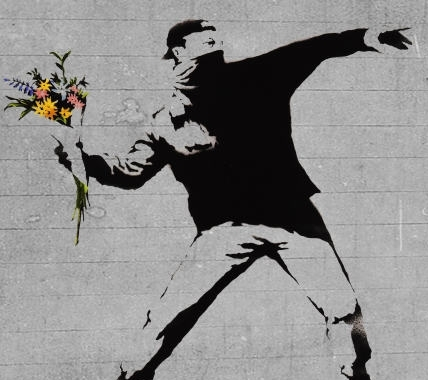Graffiti Is Art Worth Suing Over
/As someone who grew up during the heyday of The Simpsons, it’s hard for me to look at graffiti and not think of this:
It’s a nuisance, an annoyance, something to quietly cluck about on your commute to and from work. It doesn’t help matters that the graffiti you see day to day is terrible: less about the art and more about defacement, often vulgar or territorial in nature. You know, something like this:
Every so often though, you’ll get something that requires real skill and artistry, like this tag on the building I used to live in:
Or you’ll come across a Banksy or a KATSU, something that makes a statement about our world, even if it’s not particularly beautiful (although sometimes they can be).
All of these tags, regardless of beauty or social significance, are granted protection under our copyright laws. Section 102 of the Copyright Act, states that copyright protection is extended to "original works of authorship fixed in any tangible medium of expression, now known or later developed.” The works of authorship deserving of protection are:
literary works;
musical works, including any accompanying words;
dramatic works, including any accompanying music;
pantomimes and choreographic works;
pictorial, graphic, and sculptural works;
motion pictures and other audiovisual works;
sound recordings; and
architectural works.
So while the Act does not explicitly state that graffiti is protected, the language purposely leaves it open for interpretation. Which means that yes, graffiti artists can profit from their work, they can claim all exclusive rights granted under the Copyright Act (such as the right to reproduce the work, to prepare derivative works, and to sell and profit from the work), and they can avail themselves of the judicial system to enforce their rights. But while graffiti artists do get copyright protection, the rights of the artist are usually subordinate to the property rights of whomever owns the canvas. Which makes sense really… because a graffiti artist’s work relies on the defacement of someone else’s property. As I wrote two years ago:
"property is kind of a big deal in this country. The right to property is mentioned explicitly in the Fifth and Fourteenth Amendments, and the Third Amendment is built entirely around it… which means that the needs and wishes of the property owner will almost always supersede the rights of the graffiti artist."
For that reason alone, it’s rare for a graffiti artists to step forward and enforce those rights, knowing full well that they could face criminal prosecution for it. But sometimes it makes sense, like when one of your famous murals is ripped for a Katy Perry dress.
Last week, graffiti artist Joseph Tierney, also known as Rime, filed a copyright infringement lawsuit against fashion designer Jeremy Scott and his house Moschino for that exact infraction. Moschino took Rime’s design entitled “Vandal Eyes" and placed it one a dress, recently modeled by Gigi Hadid at the Met Gala (a sentence I never would’ve understood 10 years ago). Here’s a picture of the dress:
And here’s a picture of the original work:
It’s not a 1 to 1 replica, but it’s close enough to, I think, be an open and shut case. And adding fuel to the fire? The fact that Moschino included Rime’s signature on some of their clothes. Facepalm.
Rime’s case is pretty airtight and my guess is that it’ll settle. I don’t know exactly what Scott’s defenses would be. Fair use? Not likely since his entire motivation is to profit from the use of the work and placing it in a fashion context does not comment on the nature of Rime’s original mural to transform its original meaning. Scott is also not making any apparent statement about society by using Rime’s work, so he can’t really make the Banksy or KATSU argument.
I honestly cannot fathom what the point of this was, other than to make some money and maybe some headlines? This isn’t the first time Scott and Moschino have been accused of willful copyright infringement and there are definitely professional agitators out there (I’m looking at you, Richard Prince) who openly steal the work of other artists and resell them under the guise of making a statement about the nature of art and sharing and openness. I think that’s a bankrupt argument, offered by people who are trying to make easy money without doing the hard work necessary to justify it. Maybe the idea is that since the source is wall art, no one will care... as if graffiti simply by its very nature is less worthy of protection. I can understand that impulse, even if I don't condone it. I think graffiti (especially graffiti that punches up, not down) has value, even if it has to come at the financial expense of others. Why does that not have intrinsic value? Why should those artists not be able to enforce their rights?
I don’t know fashion so I can’t comment on the quality of Jeremy Scott’s work, but this is a rip off, plain and simple. It doesn’t matter if the original work is considered a criminal act throughout the country; it’s still art and that means it is worthy of protection.












